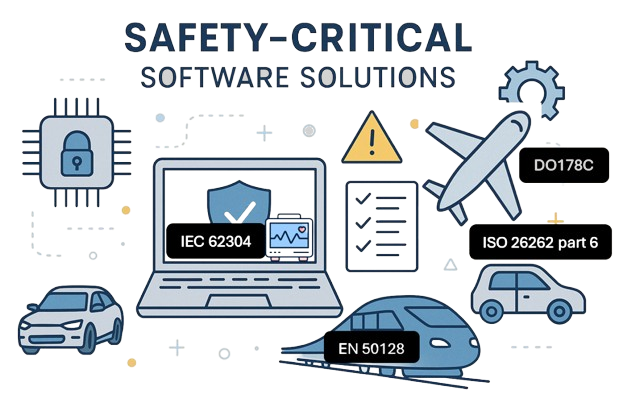Automotive (ISO26262 part 6)
ISO 26262 is a functional safety standard for the development of electrical
and electronic (E/E) systems in road vehicles. It provides guidelines to ensure that these
systems operate safely and correctly, minimizing the risk of accidents caused by malfunctioning
systems. The standard covers the entire lifecycle of a product, from conceptual development
to decommissioning,
and applies to a wide range of vehicle types.
Here's a more detailed look:
Key Aspects of ISO 26262:
-
Focus on Functional Safety:
ISO 26262 focuses on ensuring that the functions of an E/E system are performed safely and correctly, even when malfunctions occur.
-
The standard uses a risk-based approach to determine the appropriate safety requirements for each system.
-
It specifically addresses E/E systems in road vehicles, including driver assistance, propulsion, and vehicle dynamics control systems.
-
ISO 26262 provides guidance throughout the entire development process, from requirements specification to integration, verification, and validation.
-
The standard categorizes the safety requirements into Automotive Safety Integrity Levels (ASILs) from A to D, with ASIL D being the most stringent.
-
ISO 26262 promotes standardized practices and methodologies for functional safety management, helping organizations to develop and maintain safe E/E systems.
Who is it for?
-
OEMs (Original Equipment Manufacturers):
Vehicle manufacturers who need to ensure the safety of their vehicles.
-
Suppliers of E/E systems and components to OEMs.
-
Suppliers of hardware and software components that are used in E/E systems.
-
Organizations Involved in Safety-Critical Systems:
Any organization developing or using safety-critical E/E systems in road vehicles.
Benefits of ISO 26262:
-
Reduced Risk of Accidents:
By ensuring the safe operation of E/E systems,
ISO 26262 helps to reduce the risk of accidents caused by malfunctioning systems.
-
Improved System Reliability:
The standard promotes best practices in development and testing,
leading to more reliable and robust E/E systems.
-
Compliance with Regulations:
ISO 26262 is a recognized international standard for functional safety,
helping organizations meet regulatory requirements and standards.
-
By promoting safer E/E systems, ISO 26262 contributes to the overall safety and well-being of road users.

